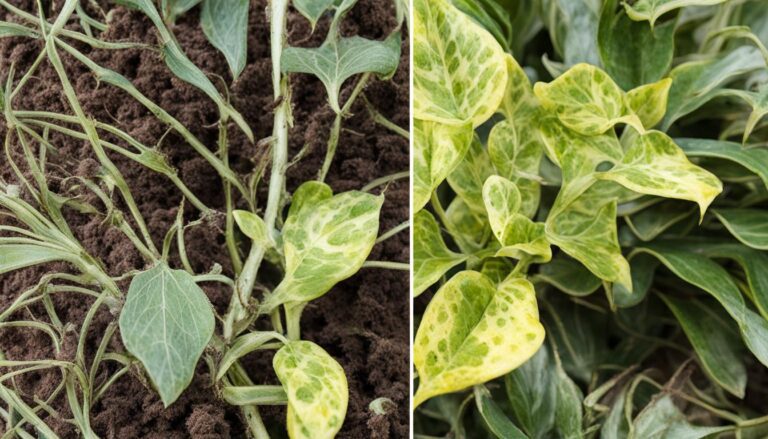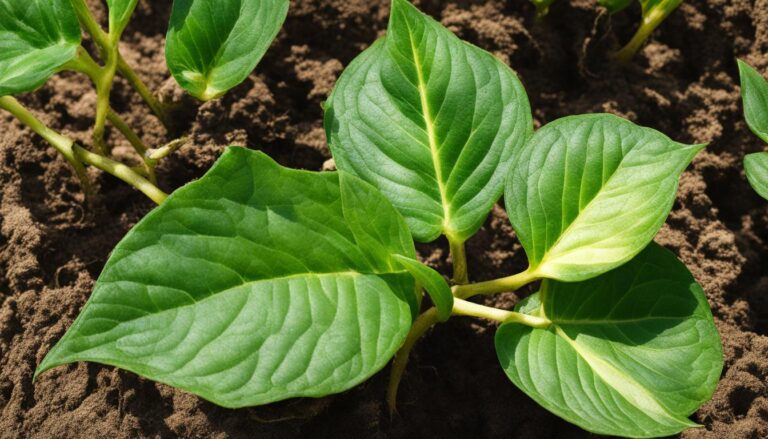
Are your houseplants looking a little sad and droopy? It could be root rot wreaking havoc on their health. But fret not! I’m here to provide you with an effective guide on how to fix root rot in your beloved houseplants with ease.
Root rot is a common issue that occurs when your plant’s roots become waterlogged and lack the necessary air to thrive. This results in decay and eventually the death of your precious greens. But fear not, because armed with the right knowledge and techniques, you can restore your houseplants to their former glory.
Key Takeaways:
- Identify the signs of root rot, such as yellowing leaves and mushy roots.
- Take prompt action by removing affected roots and repotting your plant.
- Prevent root rot through proper watering practices and ensuring good soil drainage.
- Be mindful of houseplants prone to root rot, such as ferns, peace lilies, and pothos.
- Regularly monitor and maintain plant health to prevent root rot from occurring.
What is Root Rot?
Root rot is a common problem that affects houseplants, and it is important to understand its causes in order to effectively treat and prevent it. One of the main causes of root rot is overwatering, which leads to the roots becoming waterlogged and deprived of oxygen.
This lack of oxygen creates the perfect environment for fungal infections, such as Pythium and Fusarium, which attack and rot the roots. These fungal infections are another major cause of root rot in houseplants.
Overwatering is often a result of improper watering practices, where plants are given more water than they need or watered too frequently. It is important to only water houseplants when the top inch of soil is dry, allowing for proper drainage and oxygenation of the roots.
Using pots with drainage holes and well-draining potting mix can help prevent water from pooling around the roots and causing root rot.
“Root rot can be caused by prolonged overwatering, which leads to a lack of oxygen in the roots and decay.”
Identifying root rot in houseplants is crucial for prompt intervention. Signs of root rot include wilting or yellowing leaves, mushy or slimy roots, and a foul smell. If you notice these signs, it’s important to take immediate action to save your plant.
By understanding the causes and signs of root rot, you can effectively diagnose and address the issue before it causes irreversible damage to your houseplants.
| Root Rot Causes | Fungal Infection | |
|---|---|---|
| Overwatering leads to waterlogged roots and lack of oxygen. | Fungal infections like Pythium and Fusarium attack and rot the roots. |
Identifying the Signs of Root Rot
When it comes to preventing the spread of root rot in your houseplants, early identification is key. By recognizing the signs and symptoms of this common problem, you can take immediate action to save your plant and prevent further damage. Here are some signs to watch out for:
- Yellowing Leaves: One of the first signs of root rot is yellowing leaves. As the roots become compromised and unable to absorb nutrients properly, the leaves may lose their vibrant green color and start turning yellow.
- Mushy or Slimy Roots: Gently lift your plant out of its pot and inspect the roots. If they appear mushy or slimy to the touch, it’s a clear indication of root rot. Healthy roots should be firm and white.
- Foul Smell: Root rot often comes with an unpleasant odor. If you notice a foul smell coming from the soil or the plant itself, it’s a sign that the roots are decaying and need immediate attention.
By being vigilant and regularly checking your plants for these signs, you can catch root rot early on and take the necessary steps to treat it.
Preventing Root Rot: A Proactive Approach
While it’s important to know the signs of root rot, prevention is always better than cure. By implementing a few preventive measures, you can create an environment that minimizes the risk of root rot in your houseplants:
- Proper Watering: Avoid overwatering your plants, as excess moisture is a leading cause of root rot. Water your plants only when the top inch of soil feels dry to the touch.
- Good Drainage: Ensure that your pots have drainage holes to allow excess water to escape. This helps prevent water from accumulating at the bottom, which can lead to waterlogged roots.
- Air Circulation: Provide good airflow around your plants by avoiding overcrowding. This allows the soil to dry out more quickly and reduces the chances of root rot.
By following these preventive measures and being proactive in your plant care routine, you can significantly reduce the risk of root rot and keep your houseplants healthy and thriving.
Remember, early detection and prevention are key to combating root rot. By familiarizing yourself with the signs and taking the necessary steps to create an optimal growing environment, you can ensure the long-term health and vitality of your beloved houseplants.
Treating Root Rot
When it comes to treating root rot in houseplants, prompt action is key. The first step is to remove the affected plant from the soil and carefully wash the roots to remove any soil and debris. This helps to get a clear view of the extent of the root rot and allows for proper treatment.
Next, it’s crucial to trim away all remaining affected roots using clean and sterilized pruning shears. Be sure to dispose of these roots and the contaminated soil in a sealed bag to prevent further spread of the disease.
Removing these damaged roots helps to stop the progression of root rot and allows the plant to focus its energy on regrowing healthy roots.
Once the plant has been cleaned and pruned, it’s time to repot it in fresh, well-draining potting mix. Choose a pot that is slightly larger than the previous one to allow for root growth. Make sure the new pot has drainage holes to prevent water from pooling and causing root rot again.
After repotting, water the plant sparingly and avoid overwatering, as this can contribute to the development of root rot.

Impact of Root Rot on Plant Health
Root rot can have a detrimental impact on the overall health and well-being of plants. The condition hinders the plant’s ability to absorb essential nutrients from the soil, leading to various symptoms that can severely affect its growth and survival.
One of the primary consequences of root rot is impaired nutrient absorption, which deprives the plant of the necessary elements for healthy development.
As the roots become damaged and decayed, the plant’s ability to take up water, minerals, and other vital substances becomes compromised. This can result in yellowing leaves, stunted growth, and an overall weakened appearance.
The plant may struggle to produce new foliage or flowers, and its stems may become weak and easily damaged. In severe cases, root rot can even lead to the death of the plant.
It’s important to note that root rot can also have indirect effects on the plant’s health. When the roots are compromised, the plant’s defense mechanisms are weakened, making it more susceptible to other diseases and pests.
The stress caused by root rot can trigger a cascade of physiological responses, further hindering growth and compromising the plant’s ability to cope with potential challenges.
| Impact of Root Rot on Plant Health | |
|---|---|
| Impaired nutrient absorption | Yellowing leaves |
| Stunted growth | Weakened appearance |
| Reduced defense mechanisms | Predisposition to diseases and pests |
| Physiological stress | Compromised ability to cope with challenges |
Understanding the impact of root rot on plant health underscores the importance of promptly addressing and preventing this condition.
By implementing proper watering practices, ensuring adequate soil drainage, and taking swift action at the first signs of root rot, you can help safeguard the well-being of your beloved houseplants and promote their long-term vitality.
Chemical Control Methods for Root Rot
When it comes to combating root rot in houseplants, chemical control methods can be a valuable tool in your arsenal. Fungicides, in particular, can help eliminate the fungal spores that cause the disease. It’s important to note that chemical control should be used as a last resort and with caution.
Fungicides are specially formulated to target and kill the pathogens responsible for root rot. They come in various forms, such as sprays, drenches, or granules, and can be applied directly to the soil or foliage of the affected plant. Before using a fungicide, carefully read and follow the instructions on the product label to ensure safe and effective use.
Disinfecting Tools
Alongside fungicides, it’s crucial to regularly disinfect your pruning tools to prevent the spread of fungal spores. Pruning shears, scissors, and other cutting tools can inadvertently transfer pathogens from one plant to another if not properly cleaned between uses.
To disinfect your tools, start by wiping off any visible dirt or debris. Then, soak the tools in a solution of 1 part bleach to 9 parts water for at least 5 minutes. Afterward, rinse the tools thoroughly with clean water and allow them to air dry. This simple practice can help minimize the risk of spreading root rot and other plant diseases.
| Chemical Control Methods for Root Rot | Pros | Cons |
|---|---|---|
| Fungicides | Effective in eliminating fungal spores | Should be used as a last resort and with caution |
| Disinfecting Tools | Prevents the spread of fungal spores | Requires regular maintenance and proper disinfection techniques |
While chemical control methods can be useful in managing root rot, it’s important to remember that prevention is always better than cure.
Proper watering practices, good soil drainage, and regular monitoring can go a long way in preventing the development of root rot in the first place. By taking a proactive approach to plant care, you can help ensure the long-term health and vitality of your beloved houseplants.
Non-Chemical Control Methods for Root Rot
When it comes to preventing and treating root rot in your houseplants, there are various non-chemical control methods you can employ. These methods focus on improving soil drainage and monitoring watering practices to create optimal conditions for your plants. Let’s explore some effective strategies:
Improving Soil Drainage
One of the key factors in preventing root rot is ensuring proper soil drainage. You can achieve this by creating pathways for excess water to exit the pot.
To improve drainage, consider using pots with drainage holes and using a well-draining potting mix. This will help prevent water from pooling around the roots, reducing the risk of root rot.
Monitoring Watering Practices
Proper watering is crucial for preventing root rot. Overwatering can lead to waterlogged roots, creating the perfect environment for root rot to develop. To avoid this, only water your plants when the top inch of soil is dry. This ensures that the roots have access to oxygen and prevents water from sitting in the pot, reducing the risk of root rot.
Regularly Checking Root Health
Regularly monitoring the health of your plant’s roots is essential in preventing root rot. Gently lift your plants from their pots and inspect the roots for any signs of decay or discoloration.
If you notice any mushy or slimy roots, it’s important to take immediate action. Remove the affected roots and repot the plant in fresh soil to give it a chance to recover.
By implementing these non-chemical control methods, you can effectively prevent and treat root rot in your houseplants. Remember to prioritize soil drainage, monitor watering practices, and regularly check the health of your plant’s roots.
With proper care and attention, you can keep your indoor greenery thriving and free from the threat of root rot.
| Beneficial Practices | |
|---|---|
| Improving soil drainage | |
| Monitoring watering practices | |
| Regularly checking root health |
Final Thoughts
In conclusion, preventing root rot in houseplants is crucial for maintaining their overall health and longevity. By following proper watering practices, ensuring good soil drainage, and regularly monitoring your plants, you can effectively prevent the development of root rot.
Remember to water your houseplants only when the top inch of soil is dry, avoiding overwatering that can lead to root rot. Using well-draining potting mix and pots with drainage holes will help prevent waterlogged conditions that promote root rot.
Regularly inspecting the health of your plants’ roots, removing any affected roots promptly, and repotting in clean soil can also contribute to preventing and treating root rot. By prioritizing plant health and providing optimal conditions, you can enjoy thriving indoor greenery for years to come.
After reading this, check out our other articles on:
- Effective Remedies for Yellow Leaves on Plants: Guide & Tips
- Effective Powdery Mildew Cures for Perfect Plants
FAQ
What causes root rot in houseplants?
Root rot in houseplants can be caused by prolonged overwatering, which leads to a lack of oxygen in the roots and decay. It can also be caused by fungal infections, such as Pythium or Fusarium, which attack and rot the roots.
How do I identify root rot in my houseplants?
Signs of root rot include wilting or yellowing leaves, mushy or slimy roots, and a foul smell.
What should I do if I suspect root rot in my houseplants?
If you suspect root rot in your houseplants, it’s important to take immediate action. Start by removing the plant from the soil and washing the roots to remove any soil and affected roots. Trim away all remaining affected roots and dispose of the soil in the pot. If possible, dip the remaining healthy roots in a fungicide solution. Repot the plant in a clean potting mix with good drainage.
How can I prevent root rot in my houseplants?
Preventing root rot starts with proper watering practices. Only water your houseplants when the top inch of soil is dry to avoid overwatering. Ensure that your pots have drainage holes and use well-draining potting mix. Avoid overcrowding plants and provide good airflow to prevent conditions favorable for root rot.
Which houseplants are more susceptible to root rot?
Certain houseplants are more susceptible to root rot, such as ferns, peace lilies, and pothos. These plants thrive in moist environments, making them more prone to overwatering and root rot.
What is the impact of root rot on plant health?
Root rot can severely impact the health of plants. It inhibits nutrient absorption, leading to yellowing leaves, stunted growth, and even death. If left untreated, root rot can cause the decay of healthy roots, resulting in irreversible damage to the plant.
Are there any chemical methods to control root rot?
Chemical control methods, such as fungicides, can be used to combat root rot. These should be a last resort and used with caution. Fungicides can help eliminate the fungal spores causing the disease. It’s also important to regularly disinfect pruning tools to prevent the spread of fungal spores.
Are there any non-chemical methods to control root rot?
Non-chemical control methods are often preferred for preventing and treating root rot. Improving soil drainage by creating pathways for excess water to exit can help prevent the development of root rot. Monitoring watering practices, providing good drainage, and regularly checking root health are essential preventive measures.
How can I prevent root rot in my houseplants?
Preventing root rot in houseplants requires a comprehensive approach that involves proper watering, good soil drainage, and regular monitoring. By understanding the causes, identifying the signs, and taking prompt action, you can effectively treat and prevent root rot, ensuring the health and longevity of your indoor greenery.







4 Comments
Comments are closed.